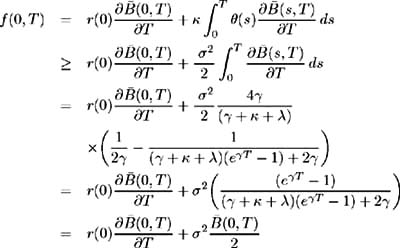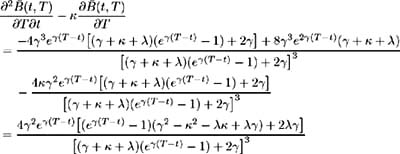11.8 Comparison of equilibrium and arbitrage pricing
11.8 Comparison of equilibrium and arbitrage pricing
The CIR model [ 18 ] (studied in Chapter 2) is an example of equilibrium pricing methodology, while the HJM model makes use of arbitrage pricing. In order to compare the two methodologies, we examine the CIR model within the HJM framework.
CIR use a square root process to model the single underlying state variable, the short- term interest rate r ( t ), t ˆˆ [0, ]. Hence the short-term interest rate process is specified as:
where the constants r (0), , ƒ > 0, ( t ) > 0 are continuous and { z ( t ): t ˆˆ [0, ]} is a standard Wiener process. To ensure that negative interest rates are precluded, the restriction 2 ( t ) ‰ ƒ 2 for all t ˆˆ [0, ] is imposed, making r ( t ) = 0 an inaccessible boundary.
The time t price of a T maturity bond ( T ˆˆ [0, ], t ˆˆ [0, T ]) is assumed to be of the form [20] :
and so, in equilibrium the bond price dynamics are represented by:
where [21]
and » is a constant related to the market price of risk such that ![]() This functional form of the market price of risk is not arbitrarily specified, but is determined directly by the underlying equilibrium economy.
This functional form of the market price of risk is not arbitrarily specified, but is determined directly by the underlying equilibrium economy.
From (11.1), the forward rate is defined as:
So, making use of (11.45) and (11.46b) the form of the forward rate curve is:

While HJM allow the initial ( t = 0) forward rate curve to be an exogenous input, here the initial forward rate curve has a pre-specified functional form. The functional form is dependent on the parameters of the specific model (i.e. , ƒ , » and ( ·)) and may be determined by evaluating (11.47) at time t =0:
To allow any specific initial forward rate curve to be matched, CIR suggest solving (11.48) for { ( t ): t ˆˆ [0, ]}, thereby determining the time-dependent short-term interest rate drift parameters from the initial forward rate curve. However, CIR do not attempt an implementation of such a methodology or prove the existence of such a solution. Additionally, the CIR model is not consistent with all possible forward rate curves, since it imposes the restriction 2 ( t ) ‰ ƒ 2 for all t ˆˆ [0, ]. Consider this restriction in terms of the parameters of the forward rate process. Substituting the restriction ( t ) ‰ ![]() into the initial forward rate process (11.48) we have [22] :
into the initial forward rate process (11.48) we have [22] :

Hence only initial forward rate curves satisfying this functional form are admissible .
One of the key features of the HJM framework is the restriction placed on the forward rate drift, which ensures that profitable arbitrage is precluded. We need to derive the forward rate process in such a form so as to verify that this restriction is satisfied within the CIR equilibrium framework. Apply Ito's Lemma to (11.47), treating the forward rate as a function of the stochastic variable r ( t ) and time t , that is f ( t, T ) ‰ f ( r ( t ), t, T ):

This is a representation of the CIR model within the HJM framework. The short-term interest rate r ( t ), written in terms of the forward rate, which is taken as the starting point of the HJM framework, is (from (11.47)):
The initial forward rate curve { f (0, T ): T ˆˆ [0, ]} is an exogenous input and is used to determine ( t ), t ˆˆ [0, ] as a solution to (11.48).
The HJM no arbitrage condition (11.29c) requires that the forward rate drift ± ( t, T ) has the form:
where ƒ ( t, T ) is the volatility of the forward rate and ( t ) the market price of risk. Within the CIR model the market price of risk has the fixed functional form ![]() and from (11.49) the forward rate volatility is
and from (11.49) the forward rate volatility is ![]() hence the forward rate drift must have the form:
hence the forward rate drift must have the form:

From (11.46a), the definition of B ( t, T ), we have:
and
Hence:

However, in (11.49) the forward rate drift is represented as:
Again from (11.46a), the definition of B ( t, T ), we have:

and so:

From (11.46c) we have:
and so

Comparing (11.50) and (11.51) we see that:
and the CIR forward rate drift satisfies the HJM no arbitrage condition (11.29c).
The fundamental difference between the above two approaches is that CIR fix the functional form of the market price of risk (this market price of risk is determined such that an underlying economy is in equilibrium) and derive the forward rate process endogenously. HJM take some form of the forward rate process (determined by an unrelated exogenous methodology) and use it to determine the prices of contingent claims, ensuring that profitable arbitrage is precluded.
[20] Here, B ( ·, ·) is used rather than the more conventional B ( ·, ·), so as not to cause confusion with the money market account B ( ·), used in the derivation of the HJM model.
[21] These are the functional forms of B ( t, T ) and A ( t, T ) as presented in equations (2.43) and (2.44) of Chapter 2.
[22] By definition of B ( t, T ) we have:
and so:

EAN: 2147483647
Pages: 132